Local museum aims to become ‘an agency of social change’ with poverty exhibit

Lindsay Advocate Publisher Roderick Benns sat down with Ian McKechnie, local historian and assistant manager of the Olde Gaol Museum, to talk about the museum’s plans for an innovative exhibit on the history and heritage of poverty in Lindsay and in the larger Kawartha Lakes. McKechnie is also The Advocate’s local history columnist.
Benns: Tell me a little about the idea for the museum to host an exhibit that has to do with poverty. What is the general idea?
McKechnie: For years, people have understood museums to be places where one goes to see “old stuff” sitting silently in glass showcases. You come in, a guide shows you around, and you leave thinking to yourself, “I have an old stack of newspapers the museum might be interested in,” or, “I have an old upright piano that I’m sure the museum will want to have in its collection.”

But museums are much more than warehouses for antique bric-à-brac. We strive to pay attention to what’s going on in the community: important anniversaries, undervalued stories, and issues our area faces today. In curating an exhibit about the history and heritage of poverty reduction in Lindsay, we’re hoping to give some historical context to a story that the Basic Income pilot is very much a part of.
We think of it as something comparatively recent, which of course it is, but it stands in a broader tradition of concerned local citizens advocating for those in need.
I think here of A Place Called Home, which grew out of efforts in the 1980s to secure affordable housing for people who otherwise had no place to go. I think, too, of the Citizens Relief Association, formed in the fall of 1931 to help local families struggling with the effects of the Great Depression.
It is important for these stories to be told, and to be told in a way that is accessible. We’re not planning on developing a permanent exhibit in the Olde Gaol Museum that you have to come and see. We’ll bring it to you — whether that’s to a school library, a church hall, a healthcare facility, or a community centre.
Portability is a key principle in guiding our exhibit design. Moreover, it is our hope that local citizens will, if they so choose, take the time to share their own stories with us as they peruse the exhibit and learn something from the stories we’ve unearthed here at the museum. This kind of exhibit development is very much an organic sort of thing.
Benns: Why is this exhibit important at this point in the history of Lindsay and Kawartha Lakes?
McKechnie: There are a few reasons. First, we want to encourage the public to modify their expectations of a museum. For too long, our mantra has been “come and see.” We want our visitors to not only come and see, but also feel inspired to “go and do likewise,” if I might quote from the famous parable. In short, we want the museum to be — through its programming and exhibits — an agency of social change in this community.
Second, we want to gather oral histories while we still have an opportunity to do so. Those who have first-hand recollections of hard times during the Great Depression, for example, are now in their nineties. It’s important to add their voices to this conversation while they’re still around.
Third, we want to use the exhibit and any related programming as an opportunity for public education; clearing up some of the misconceptions surrounding poverty reduction, and pointing to history to explain what we’re doing now and why.
Benns: What does the museum need from its community partners that might help it out?
McKechnie: Because we are a small community museum that keeps its doors open primarily through government grants and donations, monetary contributions will help us in creating a product. Quality exhibition design comes with a price.
More significantly, though, we’re looking for people who work on the frontlines of poverty reduction in this community to participate, either by sharing their own stories, or liaising with those who wish to tell their story of how this community has supported them. In addition to stories, we’re also looking for tangible symbols of poverty and poverty reduction from the past.
Perhaps you have a Depression-era meal coupon in a scrapbook, or a photo of a great-great-uncle who “road the rails” in search of work during the 1930s. In lieu of physical artefacts, we’re also inviting local artists to participate by interpreting a place like a Depression-era soup kitchen, or a massive topic such as the quest for affordable local housing, through drawing, painting, sculpture, and/or music. If there’s a way that you can contribute, by all means let us know.
Benns: What is a historical tidbit that most people might not realize about this area, when it comes to poverty and the day to day struggles families have faced over the past century or more?
McKechnie: I think we ought to remember how close many of us are to this topic. For generations, families and individuals in this community have struggled to make ends meet. For generations, ordinary people have joined forces in helping their neighbours. This was often the case during settlement, when people went and helped their neighbour down the road build a barn.
It was true in 1931-32, when local citizens donated supplies from their own root cellars to the soup kitchen operated out the Armouries. It’s true today when churches invite the less fortunate into their spaces to have a warm meal and enjoy fellowship with one another. The story seems so plain and simple, but it’s not. We hope that this exhibit will shed a light on this piece of our past.









